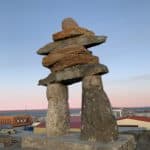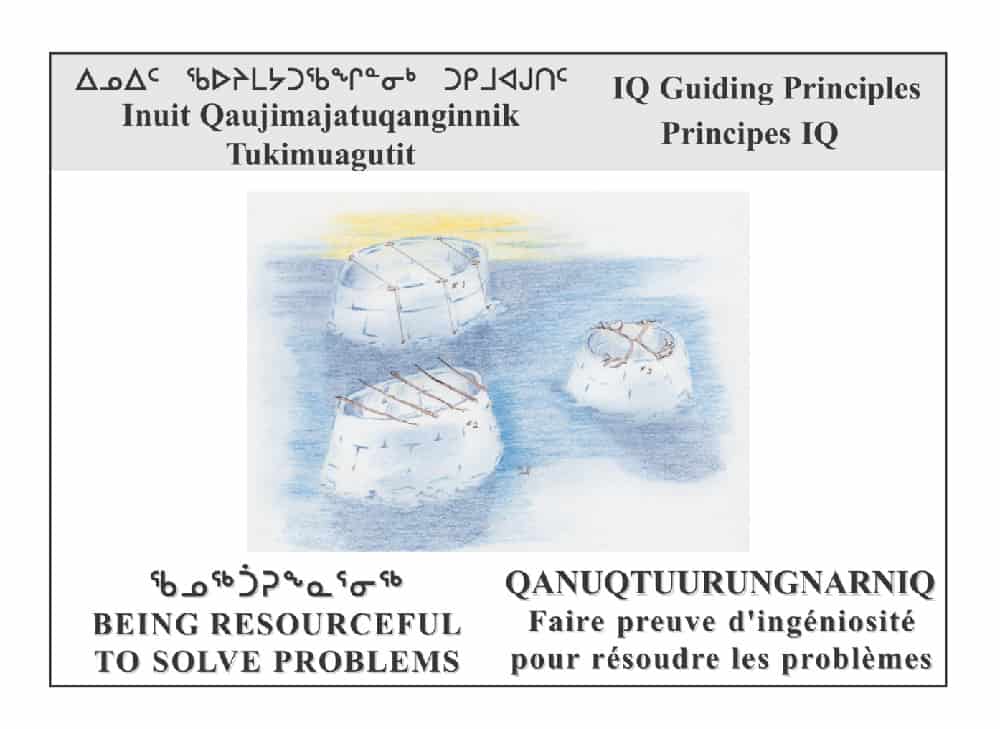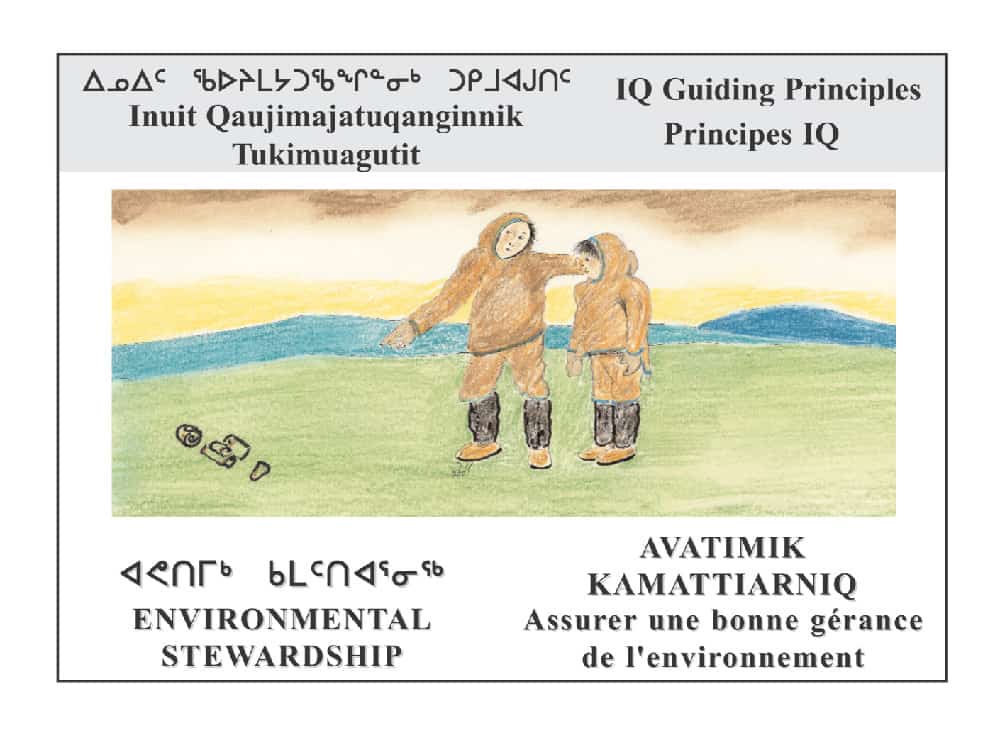Section Navigation
Message for Educator
This module provides you and your students with opportunities to explore Inuit values and cultural beliefs. We hope it will also allow you to explore the diverse value and belief systems your students bring into the classroom. Inuit say that the purpose in life is to live a good life. The information in this module will help you begin to make meaning of Inuit expectations for living a good life, especially in a changing environment where we face new challenges on many fronts.
Inuit Elders say that although the context we live in is always dynamic, our beliefs never need to change, and this is why it is so important to clarify values for youth. Inuit also say their teachings are helpful to anyone, and are not just for Inuit. With this in mind, we hope you will explore these Inuit understandings of how to live well in a dynamic world and that, in doing so, they will help you and your students set personal goals as agents of change in effectively meeting life’s challenges in order to live a good life.
– Shirley Tagalik
Introduction
Avattimik Kamatsiarniq • Respectful Stewardship
Qanurtururangniq – Leadership, innovation and seeking solutions
Topic: Becoming fit for a changing world
It is important to recognize that the Inuit worldview is highly holistic. As such, its topics resist organization according to curricular subject divisions. The units presented here are cross-curricular in nature and aim to provide an understanding of Inuit Qaujimajatuqangit (worldview) and how Inuit beliefs and perspectives set the stage for respectful stewardship of all life and the guiding principle of avattimik kamatsiarniq. A short PowerPoint document is provided as background (access to the PowerPoint).
The Inuit perspective on leadership is different from the Western one in that it is more about stewardship and taking responsibility than about influence, power or governance. Leadership qualities are identified in children and are nurtured throughout the life of the individual. A leader is considered someone who is willing to do the most unsavoury of tasks in order to serve other people. Inuit leadership is characterized by willingness to serve the common good without the expectation of recognition or reward. It does not require specific expertise or knowledge; it is rather an attitude of the heart.
Learning Goals
Students will be able to describe the expectations expressed in the Inuit worldview around stewardship, environmental responsibility and a respectful relationship with nature. They will understand how Inuit apply the principle of qanurtururangniq to prepare individuals for this critical role in life.
It should be noted that the spelling of Inuit terms often differs according to dialectal differences. The concepts remain shared despite spelling differences.
Vocabulary
Qanuqtuurniq - resourceful
Avatittinnik kamatsiarniq - stewardship
Pijitsirniq - responsibility leadership
Guiding Questions
- In the Inuit worldview, what are the characteristics of leadership and stewardship?
- How are these taught and applied as cultural expectations?
- What is the impact on the environment when these principles are not applied?
Curriculum Links
This is an interdisciplinary unit suitable for social studies, wellness and environmental sciences. Its focus is on the training of youth for their role as cultural and environmental stewards. The unit directs students to consider these roles within the context of global action.
Materials
- Diet of Souls DVD. Drumsong Communications. John Houston.
There is also a short clip available on YouTube - Elder quote sentence strips (Download the PDF for elder quotes)
- Dice
- Qanurtururangniq Reading (Download the PDF)
- Avattimik Kamattiarniq Reading (Download the PDF)
Activities
Activity 1: Introduction
A) Diet of Souls
Have the students watch Diet of Souls. As they view the film, students should take note of the significant beliefs about relationships that are expressed. They should list important points in terms of relationship to the land; to animals; to the sila (environment). Discuss their ideas as a class.
Ask:
- How does being in close and respectful relationship with nature relate to our responsibilities to the environment?
- What does this look like in our community?
- How are Inuit and Western beliefs different? What impact might these differences have on how we treat our environment?
B) Inuit Elders
Have the class form a circle. (If the class is large, conduct the exercise in smaller circles of up to 14 students.)
Cut out and fold the Elder quote sentence strips and place them in a container in the centre of each circle. Provide a die for each circle. Students take turns rolling the dice. When a student rolls a 6, they select a quote and read it aloud. The student should suggest to the group how the view expressed in the quote differs from a Western cultural perspective.
C) Defining Principles
Divide the class into pairs. Provide each pair with readings #1 and #2 – one student in the pair assigned to each reading. The task is to read the texts silently, adding ideas to the columns under the reading that help to show how leadership and stewardship are defined by the passage.
When this task is complete, students should share their responses with their partners. Together, they should add any new ideas. If time allows, sets of pairs can share their responses, or all students can share their ideas with the class.
Ask: From what you have been learning, how do you think Inuit would define leadership and stewardship? Does this way of looking at the world make a difference in how we live our lives?
Qaujigiartiit Health Research Centre is the sole copyright holder of the drawings produced by Donald Uluadluak. Reproduced with permission
Activity 2: Computer Project
Students should visit the Taloyoak – Stories of Thunder and Stone website and investigate the Elders’ interviews about animals, then respond to these questions:
- What do Elders say about the importance of animals in their lives? Provide quotes to support your ideas.
- When you read these kinds of stories, what is the predominant feeling you get from the words of the Elders? Explain why you think this is so.
- Does anything you have heard about or discussed so far lead you to think Inuit should change the way they hunt and use the land today? Explain your ideas and support them with examples.
Conclusion
Have students select a climate action program to investigate. The task is to prepare a summary of the program objectives and activities, and to explain how the program may or may not support positive stewardship among youth.
Suggestions:
- Youth Action on Climate Change
- Youth for Climate Change (UNICEF)
- Climate Action 150
- Youth Climate Lab
- Roots and Shoots Alliance for Climate Education
- Nature and Youth Power
- Shift Network
- Youth Climate Movement
- Sunrise Movement
- Climate Change Education Partnership
- UN Climate Change Learning Partnership
Resources
Additional Resources
- Royal Ontario Museum: Learning with Inuit
Social Media Resources
- Taking It Global Global Youth Action Network Youth For Climate Action/UNICEF


